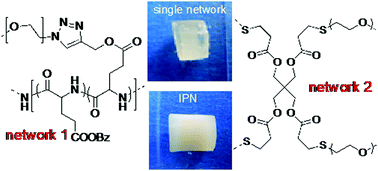Biocompatible polypeptide-based interpenetrating network (IPN) hydrogels with enhanced mechanical properties†
Abstract
Hydrogels are widely used for biomedical applications such as drug delivery, tissue engineering, or wound healing owing to their mimetic properties in relation to biological tissues. The generation of peptide-based hydrogels is a topic of interest due to their potential to increase biocompatibility. However, their usages can be limited when compared to other synthetic hydrogels because of their inferior mechanical properties. Herein, we present the synthesis of novel synthetic polypeptide-based interpenetrating network (IPN) hydrogels with enhanced mechanical properties. The polypeptide single network is obtained from alkyne functional polypeptides crosslinked with di, tri and tetra azide functional PEG by copper-catalysed alkyne–azide cycloaddition (CuAAC). Interpenetrating networks were subsequently obtained by loading of the polypeptide single network with PEG-dithiol and orthogonally UV-crosslinking with varying molar ratios of pentaerythritol tetraacrylate. The characteristics, including the mechanical strength (i.e. compressive strength (UCS), fracture strain (εbreak), and Young's modulus (E)) and cell compatibility (i.e. metabolic activity and Live/Dead of human Mesenchymal Stem Cells), of each synthetic polypeptide-based IPN hydrogel were studied and evaluated in order to demonstrate their potential as mechanically robust hydrogels for use as artificial tissues. Moreover, 1H NMR diffusometry was carried out to examine the water mobility (DH2O) within the polypeptide-based hydrogels and IPNs. It was found that both the mechanical and morphological properties could be tailored concurrently with the hydrophilicity, rate of water diffusion and ‘swellability’. Finally it was shown that the polypeptide-based IPN hydrogels exhibited good biocompatibility, highlighting their potential as soft tissue scaffolds.

- This article is part of the themed collection: Editor’s Choice: Tissue Engineering


 Please wait while we load your content...
Please wait while we load your content...